Automotive history proves that an innovative approach alone is rarely enough to save a marque from extinction. Take Studebaker as a prime example. It introduced its Wagonaire model for the 1963 model year. This variant was a Station Wagon with a sliding rear roof section that improved versatility and the vehicle’s load-carrying capacity. Unfortunately, early quality issues tarnished the Wagonaire’s reputation, and by the time the problems were addressed, the damage was done. These are rare classics, and this 1964 model is a project candidate begging for love. It is listed here on Facebook in Waynesburg, Ohio. The seller set a price of $2,800, and I must say a big thank you to Barn Finder Ted for spotting this automotive unicorn.
The history of this Wagonaire is unclear, although the faded Laguna Blue paint and significant surface corrosion indicate a total restoration is required to return this rare classic to its former glory. The seller confirms that while the frame is solid, the buyer faces significant rust repairs. There are visible issues with the floors, but the severity of these could only be determined by an in-person inspection. Externally, penetrating rust has sunk its teeth into both front fenders, the lower door corners, and the lower rear quarter panels. The buyer will face many hours of cutting and welding, and as we will see later, returning the body to a solid state will be a labor of love, where the most cost-effective solution will be the DIY approach. A couple of trim pieces are damaged, but most items are restorable. The glass looks respectable, and the original wheels have made way for a set of chrome steelies.
This photo reveals the feature that helped the Wagonaire stand apart from the competition. The rear roof section slides forward, allowing owners to carry tall items that wouldn’t fit into a typical Station Wagon. This concept was the brainchild of Brooks Stevens. The panel was manually operated, and while the idea seemed sound, design flaws tarnished its reputation. Early examples suffered front seal issues that dumped water on backseat occupants when it rained. Studebaker had cured that problem by the time this Wagonaire rolled off the line, but a more fundamental problem could bite owners. The channels for the sliding panel feature drainage holes to evacuate water. These could become blocked if an owner didn’t inspect them regularly. The result was accumulated moisture that caused rust problems. Repairs were expensive because the channels required a precision fit to ensure adequate sealing. Wagonaire production totals were low, but many otherwise solid vehicles met their end in a scrapyard due to the prohibitive repair costs. However, this classic’s channels look to have avoided that problem.
The restoration work on this Studebaker won’t be confined to its panels and paint because the interior has deteriorated significantly. The upholstered surfaces are beyond repair, the wheel and pad are cracked, and some dash components exhibit noticeable deterioration. None of these issues are beyond addressing, but they won’t be cheap to repair. Sourcing interior trim might be challenging, but a persistent online search may yield positive results. Otherwise, handing the surviving pieces to a competent upholsterer for use as templates might be the best option.
It is unclear what engine initially powered this Wagonaire because buyers could select from a range of six-cylinder and V8 powerplants. A previous owner scrapped the original motor and transmission, slotting in a 350ci V8 and an automatic transmission from Chevrolet. That should provide a performance gain but won’t impress those considering a faithful restoration. Sourcing the correct components is possible, but parts availability for the Bow-Tie powertrain could make maintaining the status quo irresistible. The seller states the small-block runs fine, but potential buyers shouldn’t consider the Wagon close to roadworthy. They describe the drivetrain installation as poor quality, the brakes don’t operate, and it seems there are other faults requiring attention. A competent new owner might be able to address most of the issues in a home workshop, but this is another aspect requiring an in-person assessment to gauge the project’s viability.
This 1964 Studebaker Commander Wagonaire appears to be an affordable project candidate if taken at face value. Its problems aren’t insurmountable, and the fact that under 3,000 of these Wagons rolled off the line in 1964 confirms its rarity. However, rarity does not always equate to a high potential value once the work is complete. Recent sales results demonstrate that even a high-end build will net a price of around $20,000 in the current market, and values aren’t climbing. That only leaves approximately $17,000 in the pot after purchase to complete the work before financial viability becomes an issue. That may deter some, but some enthusiasts are less concerned about the cost than the experience of owning a rare classic. This could be the ideal candidate if you fall into that category. Do we have any takers?
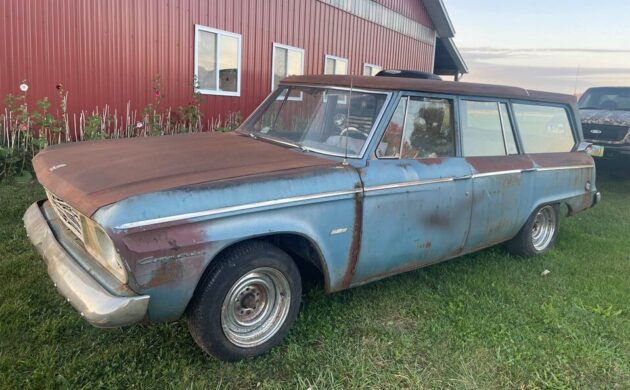
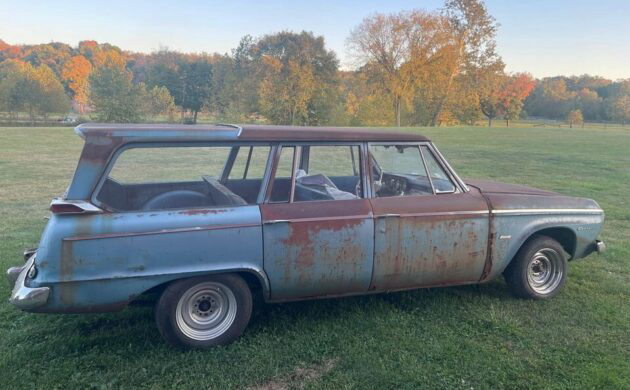
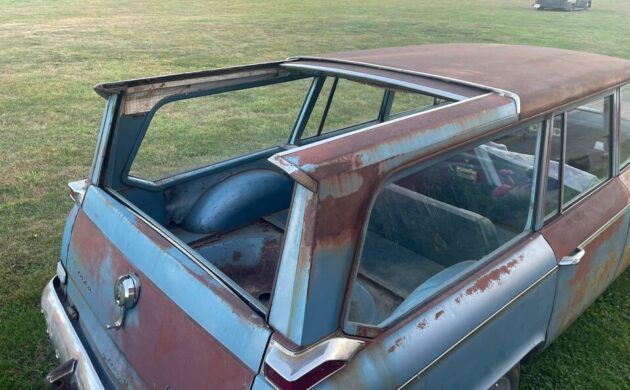
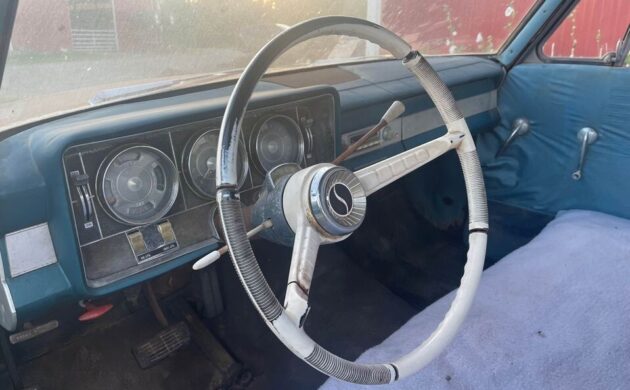
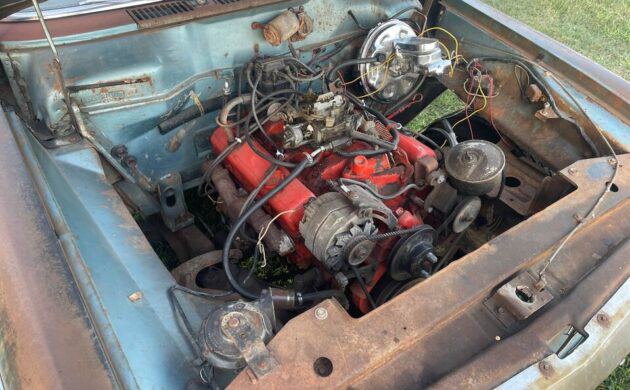


I believe that the white steering wheel indicates that it was built at South Bend before Studebaker production ceased in December, 1963.
Hopefully someone will buy and restore it. It will be a shame if it goes to the crusher.
Not here. That one’s a thrasher! GLWTS.
By the emblem on the right front fender idicates it was a V8. My guess it was a 259. With everything needed you would be underwater pretty quick.
You would be under water only if you couldn’t close the sliding roof.
I had a Matchbox toy of one of these; never seen a real one as they weren’t sold here.
In the last 20 years I’ve seen at least three in central Montana.
These didn’t come with inner fenders on the front? Was that a cost-saving measure by Studebaker? Odd to see so much earth showing in the photo of the engine bay!
It looks like the front inner fenders were cut away or cut off…. maybe rusted away!
Probably removed to fit the poorly executed 350 Chevy V8 installation.
That year studebaker used chevrolets 283v8 so the 350 is physically the same
Supposedly, 1964 Studebakers used
Studebaker engines, as there was a backlog
of Stude V-8s, which were shipped to the
Hamilton, Ontario plant. The Chevy engines
were, however, installed in 65-66 Canadian
Studebakers.
NC, no the 65s and 66s used the 283. 64 was still the Stude 259 or 289.
It may be a money pit but it’s a cool money pit and is worthy of at least attempting to save it. How many of these are still in existence? Not many, I assure you. While they may not be bringing in high dollars at present, the recent rise in interest in wagons and in oddball cars is in my opinion going to be turning to these cars before long and when that happens the value of them is going to go up a lot and those who scrapped these cars — even in the condition of this one, will be kicking themselves for not saving it. Hindsight is 20/20, but foresight is a rare ability. Once something is gone, it is gone and there won’t be another. If I had the money to buy it I would, even if I was to just put it in storage for the immediate future. Maybe oil the rust areas to slow it down, and let the values rise.
Thanks for writing this one up, Adam! When I saw it on FB, it just caught my attention! I marvel at all the readers who are able to add additional information to any car that is featured on Barn Finds!
Having two cars in storage (45 years +!) myself, it is sad to see projects halted due to the “reality of life” getting in they way. Has BF ever done follow up features of restored projects?
Thanks again, Adam!
Drainage channels on moon roofs are still a problem. Just saw an article related to it. People wanting warranty work because they clog and cause damage. Unbeknownst to them tho, it says in the book to maintain and that clears the manufacturer of any liability.
I owned both versions of the Wagonaire, the ’63 & ’64. The water leaks are due to the front drains having small steel drain pipes [3/8″] that are then connected to rubber tubes that take the water down the center door posts. When the lines were plugged with dirt, many mechanics tried to use compressed air to unclog them, resulting in the rubber tubes being blown off the steel lines!
I’ve always said if you live in an area where it rains, don’t park the car with the front of the car pointing downhill. When you wash the car, park it so the back end is lower than the front, so all the built-up dirt & water will flow out the back of the car, flushing out the channels.
In the late 1970s a friend of mine in the Studebaker Club found a 1-owner 1964 Studebaker Daytona Wagonaire. It was red with a red bucket seat interior. It had a factory-installed 289 R-1 hi-performance Avanti drive train, with a 4-speed, posi-rear diff, & dual exhaust. It was loaded with almost all the options, power steering & power disc brakes, A/C, tach, power windows, even the rare AM/FM radio.
Problem was, the car had been parked for about 6 years with the nose pointing down, under a line of long-leaf pine trees. The car was covered in pine needles, and always in the shade. Basically the entire lower 6″ of the body was rusted away, and the interior was covered in mold. Always wondered what happened to it.
I saw one with a R2 4 speed in South Bend at the national meet in the early 70s. It had a lot of rust too. You could lift the left front fender up like a wing.
Vincent,
You sound like a long-time SDC member. Do you remember a Studebaker parts supplier Dan W. from Maryland? That red R1 Daytona Wagon belonged to Dan.
The pine needles had managed to get between the door glass and the door shells, and eventually clogged those damn narrow water drains in the doors. All 4 doors were rotted, as the water had collected inside, eventually entering the inside of the car thru the openings behind the door panels, and those were also destroyed. Looking from the outside of the driver’s door, I could see the pedals inside!
We had a 63 lark sedan that was so terribly rusted, we parted it out. One of my techs was funnin’ around with the car before we had it hauled to the scrapyard. He opened both rear doors, and bent them upwards until the 2 rear doors & posts were above the car, forming a big overhead triangle, and he also DID bend the front fenders outwards and up until they were horizontal. I wish I had photographed it before it left for the big junkyard in the sky!
Dan Weber he past away a while back. That sounds like that Lark was fun, Yes I have been a SDC member since 1969. Did you ever come to the York Swap Meet?
Vincent,
I used to ride up with Dan or follow him in my vehicle, as York was not that far away. sometimes I would bring more of Dan’s Studebaker parts in my van or pickup, if it wouldn’t all fit in his truck.
Dan and I had an arrangement that if either of us bought Studebaker and/or Packard parts, we would give each other first dibs on the “other” make’s parts, he wanted the Studebaker stuff, I wanted the Packard parts.
For a long time I didn’t visit him at his place, as I had an allergy to tobacco smoke that was getting worse, and he [as you probably know] chain smoked cigs. That and I just didn’t get along with his wife Crissy and her dogs.